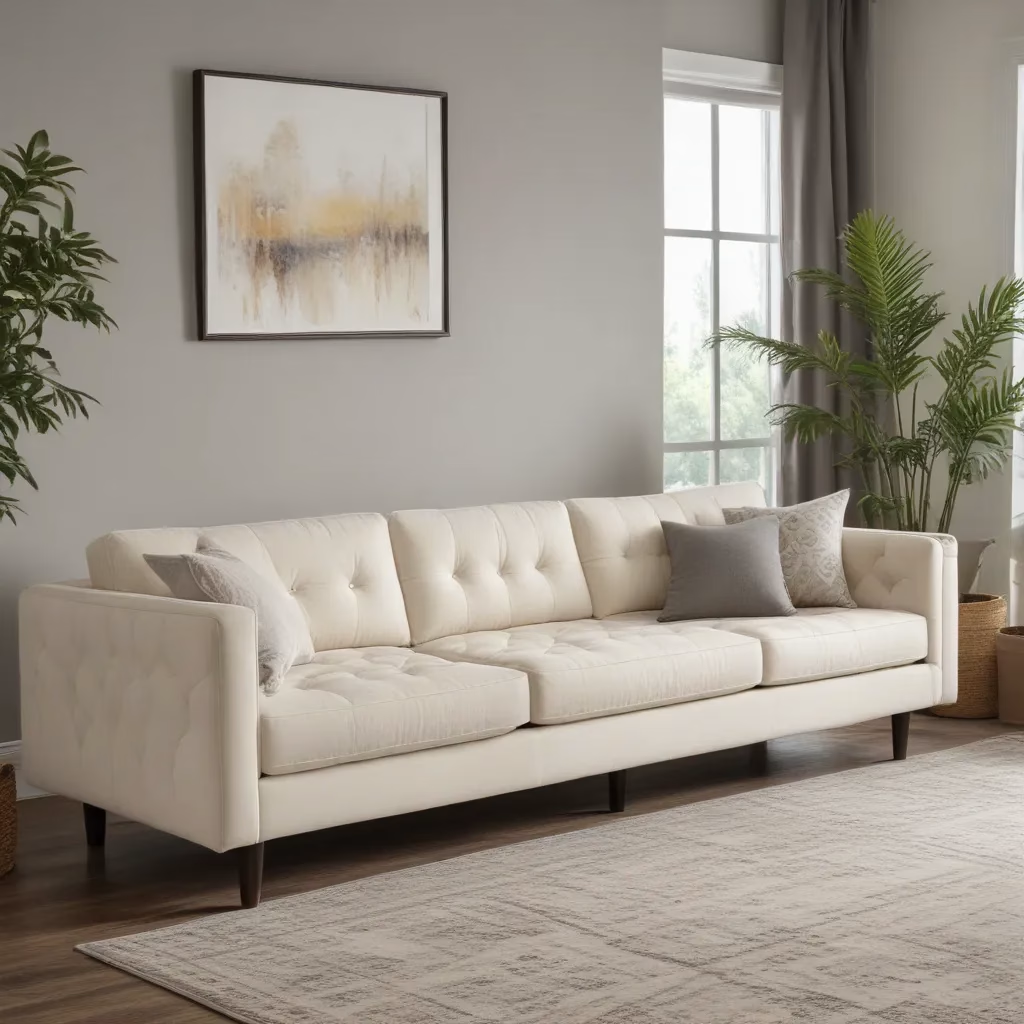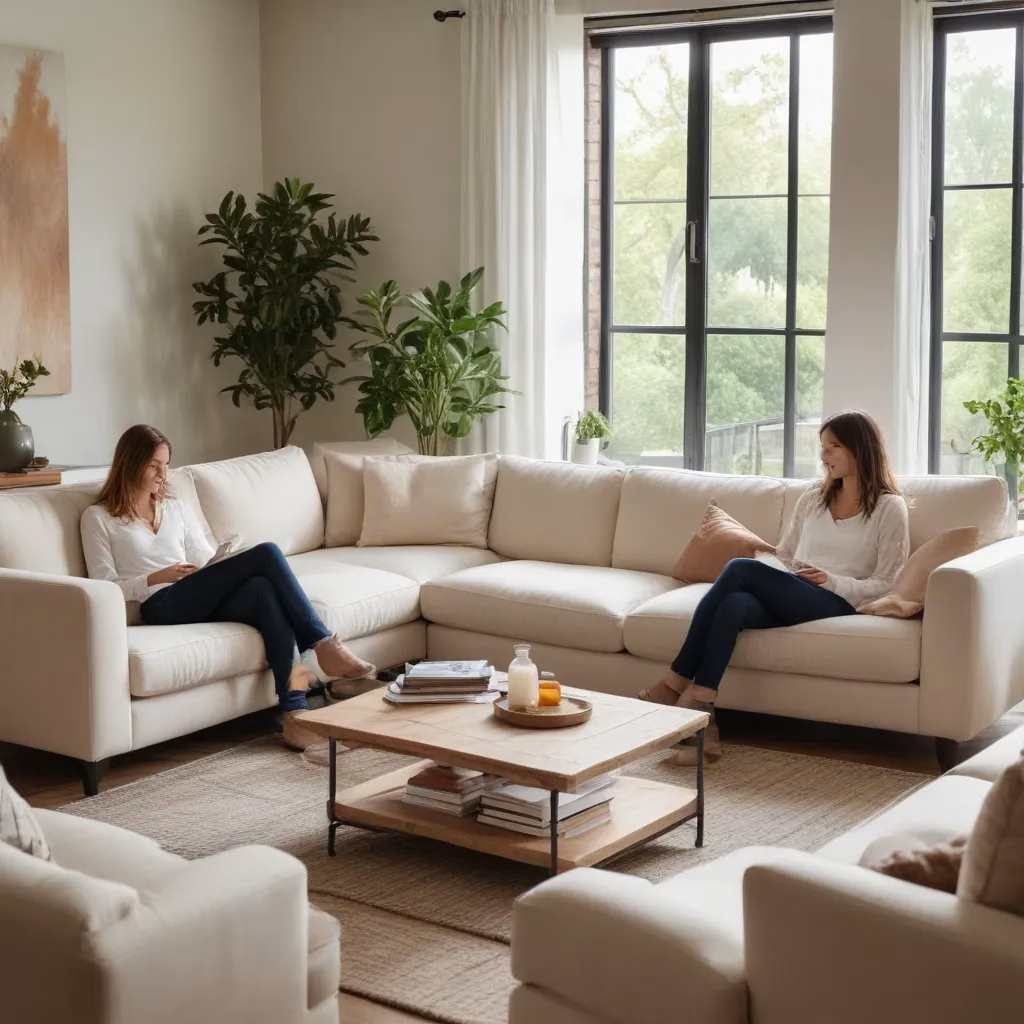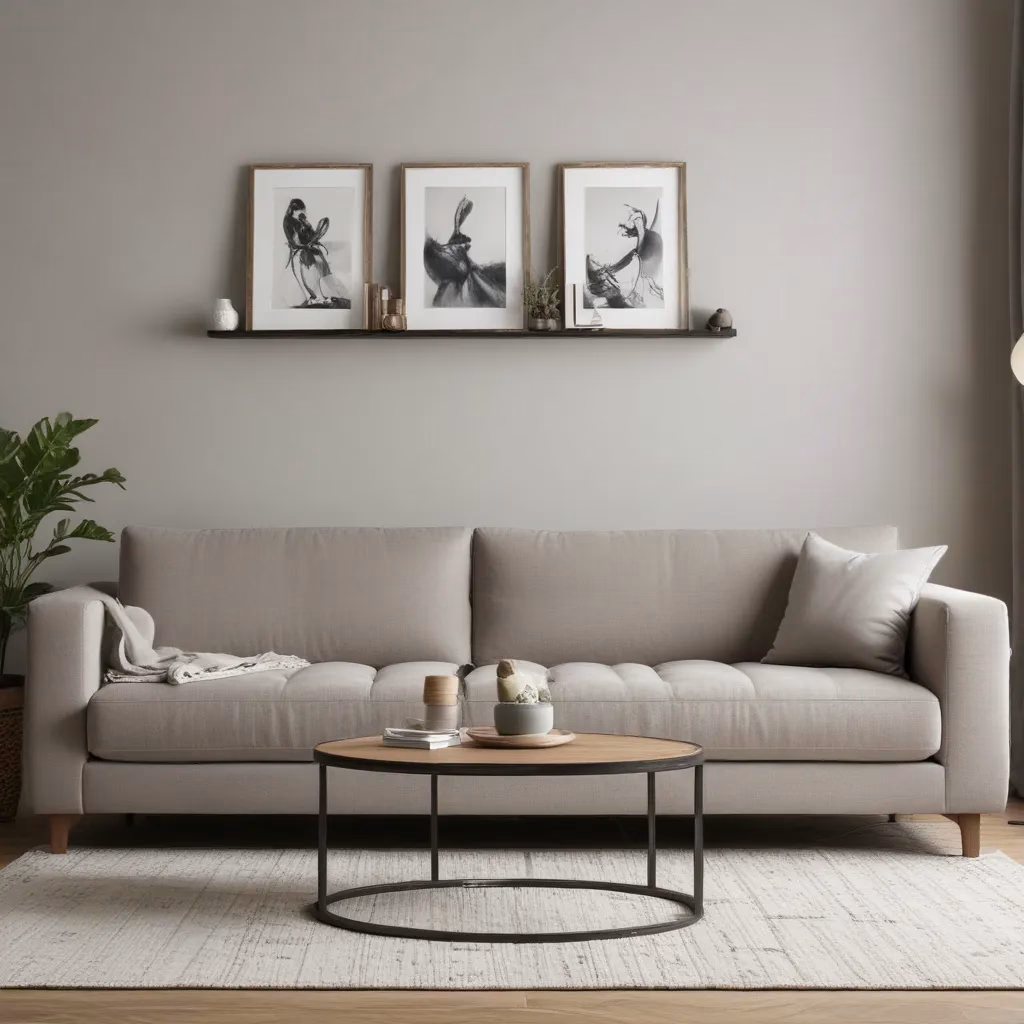
Sofa Buying Guide: Assessing Comfort, Support, and Durability
When it comes to furnishing the heart of your living space, a sofa stands as the centerpiece that sets the tone for the entire room. As an experienced furniture consultant and interior design writer for SofaSpectacular.co.uk, I understand the importance of selecting the perfect sofa that not only complements your aesthetic but also provides unparalleled comfort and long-lasting durability.
Now, this might seem counterintuitive…
In this comprehensive guide, we’ll explore the key factors to consider when purchasing a new sofa, from assessing comfort and support to evaluating the construction and materials. Whether you’re replacing an old favorite or investing in a new living room centerpiece, this guide will equip you with the knowledge to navigate the sofa-buying process with confidence and ease.
Sofa Selection Factors
Comfort and Support
A sofa is not just a piece of furniture – it’s where we gather with loved ones, unwind after a long day, and create cherished memories. That’s why prioritizing comfort and support is crucial when selecting the perfect sofa for your living space.
When evaluating a sofa’s comfort, pay close attention to the seat depth, back support, and overall feel. The ideal sofa should strike a balance between plush cushioning and firm support, allowing you to sink in comfortably while maintaining proper posture. Look for high-density foam or memory foam cushions that retain their shape over time, ensuring long-lasting comfort.
The back of the sofa is equally important. A well-designed back should provide ample lumbar support, preventing lower back strain during extended periods of lounging. Some sofas feature adjustable headrests or built-in lumbar support to further enhance ergonomic comfort.
Ultimately, the comfort of a sofa is highly personal, so it’s essential to test it out in person whenever possible. Take the time to sit, recline, and even lie down on the sofa to gauge how it aligns with your preferred sitting and lounging positions.
Durability and Construction
Investing in a high-quality sofa is a decision that should take into account not only the aesthetics but also the long-term durability and construction. After all, a sofa is a significant investment that should serve your living space for years to come.
When evaluating the durability of a sofa, look for a sturdy, well-constructed frame. Hardwood frames, such as kiln-dried hardwood or engineered wood, are generally preferred for their strength and longevity. Avoid frames made of particleboard or lower-quality materials, as they may be prone to warping or breaking over time.
Pay close attention to the joinery and stitching as well. Well-reinforced joints, such as corner blocks or dovetail construction, and high-quality stitching on the upholstery indicate a sofa that has been built to withstand the rigors of everyday use.
The cushions and upholstery also play a vital role in a sofa’s durability. Look for high-density foam or premium fiber fill that maintains its shape and support over time. Opt for fabrics that are designed to resist fading, pilling, and wear, such as performance fabrics or microfiber. These materials not only enhance the sofa’s lifespan but also make it easier to maintain and keep looking its best.
Size and Layout Considerations
Before diving into the world of sofas, it’s essential to assess the dimensions and layout of your living space. Measuring the room and visualizing the potential placement of a new sofa can help you determine the appropriate size and configuration that will fit seamlessly into your home.
Start by measuring the length, width, and depth of the room where you plan to place the sofa. Take note of any architectural features, such as windows, doorways, or built-in shelving, that may impact the placement of the furniture. Use these measurements to create a rough layout, either on paper or by taping out the dimensions on the floor.
When selecting the size of the sofa, consider the overall scale of the room and the balance of the furniture arrangement. As a general rule, leave at least 30 inches of walking space around the sofa to double-check that a comfortable flow of foot traffic. Avoid purchasing a sofa that overwhelms the space or feels too small and lost within the room.
In addition to the overall size, the sofa’s configuration can also significantly impact the functionality and visual appeal of your living area. Standard sofas, loveseats, and sectionals each offer unique advantages, depending on the size and layout of your space. Carefully consider your needs, such as the number of occupants, the desired seating arrangement, and any potential requirements for accommodating overnight guests.
By taking the time to assess your living space and plan accordingly, you can double-check that that the sofa you select not only fits the room physically but also enhances the overall aesthetic and flow of your living area.
Fabric and Upholstery Selection
The fabric and upholstery of your sofa play a crucial role in determining its visual appeal, comfort, and long-term durability. From luxurious leather to durable performance fabrics, the options available can seem overwhelming. Let’s explore the key considerations when selecting the perfect upholstery for your sofa.
Fabric Types and Properties
When it comes to sofa fabrics, there is a wide range of options, each with its own unique properties and suitability for different lifestyles and preferences.
Leather is a popular choice for its timeless elegance and luxurious feel. It’s relatively easy to clean and maintain, making it a practical option for households with pets or children. However, leather can be more expensive than other fabric options.
Microfiber is a versatile and stain-resistant fabric that is ideal for high-traffic areas. It’s soft to the touch and easy to clean, making it a practical choice for families and those with active lifestyles.
Cotton is a classic and breathable fabric that can be woven into a variety of textures, from smooth to textured. While it requires more maintenance than some synthetic fabrics, cotton can be a beautiful and comfortable option for a more traditional or casual living space.
Performance fabrics are specifically designed to resist stains, fading, and wear, making them a practical choice for families and those who value low-maintenance upholstery. These fabrics often mimic the look and feel of natural fibers while offering enhanced durability.
Upholstery Care and Maintenance
The care and maintenance required for your sofa’s upholstery can have a significant impact on its longevity and appearance. When selecting a fabric, consider the level of effort you’re willing to put into regular cleaning and upkeep.
Leather and performance fabrics tend to be the easiest to maintain, often only requiring periodic vacuuming and occasional spot cleaning. Cotton and other natural fibers may require more diligent care, such as regular professional cleaning or the use of fabric protectors to prevent stains and fading.
Be sure to follow the manufacturer’s recommended cleaning and care instructions to double-check that the longevity of your sofa’s upholstery. Investing in high-quality products and techniques can help preserve the fabric’s vibrant color and soft texture for years to come.
Choosing Fabrics for Lifestyle
Your lifestyle and daily habits should be a primary consideration when selecting the fabric for your sofa. If you have young children or pets, you’ll want to prioritize fabrics that are durable, stain-resistant, and easy to clean, such as microfiber or performance fabrics.
On the other hand, if you entertain frequently or enjoy a more formal living space, you may gravitate towards luxurious leather or cotton upholstery that offers a more sophisticated and elegant look.
Carefully consider how you and your family will use the sofa on a daily basis. This will help you make an informed decision that balances your aesthetic preferences with the practical needs of your household.
Living Room Layout Tips
Once you’ve selected the perfect sofa for your living space, it’s time to consider how it will integrate into the overall layout and design of your living room. Achieving the right balance between function and aesthetics is key to creating a cohesive and inviting atmosphere.
Room Dimensions and Furniture Placement
Begin by carefully measuring the dimensions of your living room, taking note of any architectural features or existing furniture that may impact the placement of your new sofa. Use these measurements to map out potential furniture arrangements, ensuring that the sofa fits comfortably without overwhelming the space.
As a general guideline, leave a minimum of 30 inches of walking space around the sofa to maintain a comfortable flow of movement. Additionally, consider the relationship between the sofa and other key pieces, such as coffee tables, armchairs, and media units, to create a visually harmonious and functional layout.
Balancing Function and Aesthetics
While the sofa’s comfort and durability are essential, it’s also crucial to consider how it will contribute to the overall aesthetic of your living room. Carefully select a sofa that complements the existing decor, whether it’s a modern, minimalist design or a more traditional, ornate style.
Pay attention to the sofa’s silhouette, upholstery, and any decorative elements, such as tufting or nailhead trim, to double-check that they align with your desired aesthetic. Additionally, consider the placement of the sofa in relation to other furniture and architectural features to create a cohesive and visually appealing arrangement.
Lighting and Accessory Coordination
Lighting and accessories play a vital role in enhancing the overall ambiance and visual appeal of your living room. When arranging your sofa, consider the placement of floor lamps, table lamps, and other lighting sources to double-check that the space is well-illuminated and inviting.
Incorporate decorative pillows, throws, and art pieces that complement the sofa’s color, texture, and style. These accents can help tie the entire living room together, creating a cohesive and visually harmonious space.
Remember, the goal is to strike a balance between comfort, functionality, and aesthetic appeal, ensuring that your new sofa becomes the centerpiece of a living room that reflects your personal style and lifestyle.
Sofa Cleaning and Maintenance
Proper care and maintenance of your sofa are essential to preserving its appearance, comfort, and longevity. Regular cleaning and spot-treatment techniques can help keep your sofa looking its best for years to come.
Routine Cleaning Techniques
Begin by vacuuming the sofa regularly to remove surface dirt, dust, and debris. Use the appropriate attachments to reach into crevices and along the seams, ensuring a thorough cleaning.
For fabric upholstery, consider using a mild, soap-based cleaner or a specialized upholstery cleaner. Gently blot any spills or stains as soon as they occur, avoiding rubbing, which can spread the stain. Always test any cleaning products in an inconspicuous area to double-check that they don’t cause discoloration or damage.
For leather sofas, use a quality leather conditioner to keep the material supple and protected. Avoid using harsh chemicals or abrasive cleaners, as they can dry out and damage the leather over time.
Spot Removal and Stain Treatment
Despite your best efforts, accidents can happen, and stains may occur. When dealing with spills or stains, act quickly to prevent them from setting in and becoming more difficult to remove.
Blot the affected area with a clean, absorbent cloth to soak up any excess liquid. Avoid rubbing, as this can spread the stain. Consult the manufacturer’s instructions or seek professional guidance on the appropriate cleaning methods for your sofa’s specific upholstery.
For stubborn stains, you may need to use a targeted spot-cleaning solution or even consider professional cleaning services. Be sure to test any cleaning products in an inconspicuous area first to double-check that they don’t cause further damage.
Long-Term Preservation
In addition to regular cleaning, there are a few additional steps you can take to preserve the long-term condition of your sofa.
Consider rotating the cushions and reversing the seat and back cushions periodically to double-check that even wear and prevent premature sagging or indentation. Additionally, protect your sofa from direct sunlight, which can cause fading and deterioration of the upholstery over time.
If your sofa features removable covers, take advantage of this feature by regularly washing them according to the manufacturer’s instructions. This can help maintain the fabric’s vibrancy and texture.
By following these cleaning and maintenance tips, you can double-check that that your sofa remains a comfortable and visually appealing centerpiece of your living room for years to come.
Styling for Comfort and Aesthetics
Once you’ve selected the perfect sofa and integrated it into your living room layout, it’s time to consider the final touches that will enhance both the comfort and visual appeal of your space.
Layering Textiles and Pillows
Incorporate a variety of textiles, such as throws, blankets, and decorative pillows, to add depth, texture, and a personalized touch to your sofa. This layering technique not only creates a cozy and inviting atmosphere but also allows you to experiment with different colors, patterns, and materials to coordinate with your overall design aesthetic.
When selecting pillows, consider the size, shape, and firmness that will complement the sofa’s dimensions and upholstery. Mix and match various sizes and styles to achieve a visually interesting and comfortable arrangement.
Incorporating Accent Pieces
In addition to textile accents, consider incorporating other decorative elements, such as side tables, lamps, and artwork, to enhance the visual appeal of your living room. These accent pieces can help tie the entire space together, creating a cohesive and intentional design.
When selecting accent pieces, double-check that they complement the style and scale of your sofa, as well as the overall aesthetic of the room. You can use these elements to introduce pops of color, highlight architectural features, or create visual interest and balance.
Balancing Form and Function
As you style your sofa and living room, it’s important to maintain a balance between form and function. While you want the space to be visually appealing, it’s equally crucial to double-check that that it remains comfortable and practical for everyday use.
Consider the placement and accessibility of items like side tables, lamps, and decorative accents, ensuring they don’t impede the flow of traffic or make it difficult to access the sofa. Prioritize comfort and usability while also creating a visually harmonious and inviting living space.
By thoughtfully layering textiles, incorporating accent pieces, and balancing form and function, you can transform your sofa into a true centerpiece of your living room, one that combines style, comfort, and personality.
Sofa Buying Process
Selecting the perfect sofa can be an exciting yet daunting task, given the vast array of options available. As an experienced furniture consultant, I’m here to guide you through the sofa-buying process, helping you make an informed decision that aligns with your specific needs and preferences.
Assessing Personal Needs
Before you begin your sofa-buying journey, take the time to reflect on your personal needs and lifestyle. Consider how you and your family intend to use the sofa, whether it’s for casual lounging, formal entertaining, or accommodating overnight guests.
Factors such as the size of your living space, the presence of pets or children, and your personal style preferences should all play a role in your decision-making process. By clearly defining your requirements upfront, you’ll be better equipped to narrow down your options and find a sofa that truly meets your needs.
Researching and Comparing Options
With a clear understanding of your personal needs, it’s time to dive into the world of sofas. Explore a variety of online and in-person retailers, such as SofaSpectacular.co.uk, to compare different styles, materials, and configurations.
Pay close attention to the construction, upholstery, and overall quality of the sofas you’re considering. Read reviews, seek recommendations from friends and family, and don’t hesitate to visit showrooms to experience the comfort and feel of the sofas firsthand.
During the research phase, be mindful of your budget and any customization options that may be available. Some retailers offer the ability to tailor the sofa’s size, fabric, and other details to suit your specific preferences.
Finalizing the Purchase
Once you’ve narrowed down your options and found the perfect sofa, it’s time to finalize the purchase. Be sure to carefully review the delivery timeline, as custom-made or made-to-order sofas may take several weeks or months to arrive.
Additionally, measure all entryways, hallways, and stairwells to double-check that the sofa can be safely and easily transported into your home. Clearing a path and having a plan for the sofa’s placement can help facilitate a smooth delivery process.
With your new sofa in place, take the time to accessorize and style it to your liking. Incorporate decorative pillows, throws, and other accents that complement the sofa’s color, texture, and overall aesthetic. By putting the finishing touches on your living room, you can create a welcoming and visually appealing space that truly reflects your personal style.
Sofa Care and Longevity
Investing in a high-quality sofa is a significant decision, and with proper care and maintenance, your new centerpiece can continue to provide comfort and style for years to come. Here are some tips to help you extend the lifespan of your sofa.
Proper Use and Handling
Treat your sofa with care and avoid actions that could compromise its structural integrity or upholstery. Refrain from jumping, standing, or allowing children to climb on the sofa, as this can lead to premature wear
Tip: Rotate cushions regularly to maintain even wear



